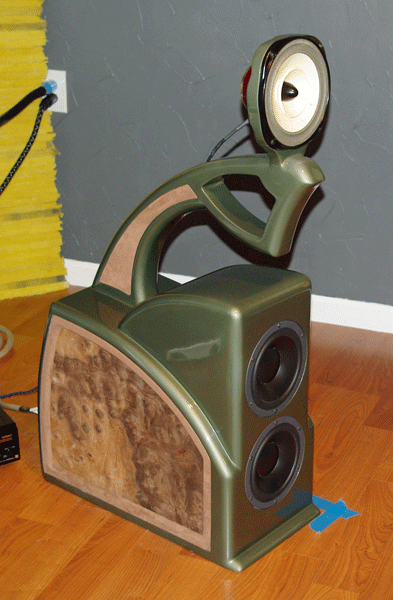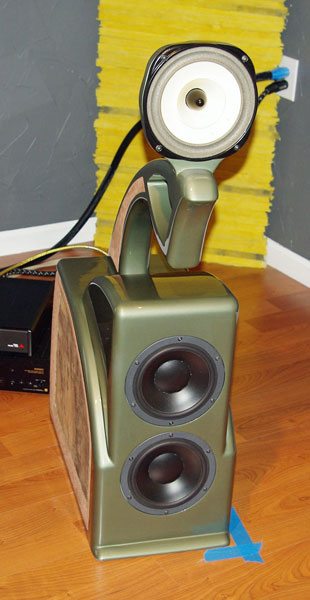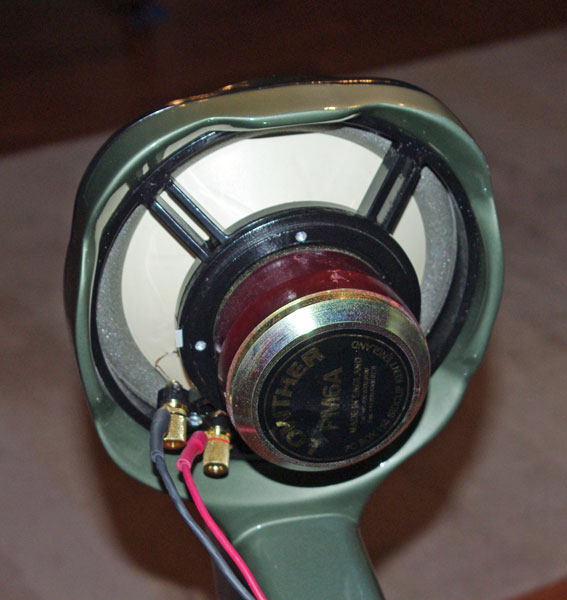|
You are reading the older HTML site
Positive Feedback
ISSUE
52
An Artist Builds a Loudspeaker
I recently got an invitation from Randy Kunin of Sounds by Design to visit his listening room and hear the speakers that he is building. Randy makes "Functional Audio Art," i.e., custom loudspeakers, in nearby Warrenton, Missouri. A custom loudspeaker is not really a reviewable item. Each one is, by definition, different, so no single review can accurately reflect all the possible sonic variations. Still, the pictures on the web site were interesting and the prospect of hearing a speaker that is clearly not from the rectangular-box-school-of-design was appealing. Randy is an audiophile, artist, and speaker designer. His intention is to make speakers that provide exceptional sound while fulfilling his artist's ambition to imbue each pair of them with physical uniqueness. At their core, his speakers are a remarkable combination of form in the service of function.
The speaker shown in the photo is referred to by Randy as the "Sedition." And, yes, that is a Lowther driver, a PM6A, 16 Ohms with a silver voice coil. This is not, however, a Lowther speaker. While is looks like one of the myriad attempts to make a full-range speaker around a Lowther driver (and succeeds remarkably) the Lowther is used because it happens to fulfill the function of mid/treble driver in the way that Randy wants it to. If there were another driver that would accomplish this task, Randy would be using it. Don't be distracted by the Lowther. The Lowther reproduces frequencies from around 350Hz to its upper limits. Frequencies below 350Hz are handled by a pair of Dynaudio 8-inch MW172 drivers operating in a sealed enclosure. Internal wiring and connectors are all high end products by Cardas. The cabinet construction is of MDF using the same "translam" form of construction as Magico. The cabinet is built from front to back of individual layers of MDF. The internal volume of each layer is removed to provide the cabinet's internal cavity. Each layer, however, is made slightly differently so that there are no significant resonant modes. This construction is expensive and labor intensive but it results in a cabinet that is dense, heavy and as dead as a material object can be. The "neck" of the cabinet positions the open-backed Lowther driver at the ideal listening height and at a front/back distance that puts it in proper time-alignment with the woofers. The quality of the Sedition's painted finish is exquisite; the side inserts are of leather—purely decorative but very attractive.
Listening The Seditions are designed for bi-amplification. They were bi-amped using a Korato Anniversary amp for the bass and a modest Audio Refinement Multi 3 amp for the Lowther driver. The source was an inexpensive Sony DVD player feeding a Museatex Bidat DAC. A Korato KVP 20 preamp controlled the volume. The electronic crossover, which is pivotal to the design, was from mini dsp. www.minidsp.com. My initial impressions of the Sedition were that these speakers sounded very spacious if also slightly unfocused as to image location—at least compared to my own system. I had brought a Jane Monheit CD with and thought her voice sounded extremely good and other than the subtle image vagueness found nothing to complain of. Every system is slightly different and there is always some accommodation needed when hearing a new system. Randy and I listened for almost three and a half hours. The time flew by as it does when you are hearing something special. Toward the end of my listening session, I found that there was far less vagueness in image location than had been there when we started. Possibly some of it was simply getting the equipment fully warmed up. Bill Frisell's Beautiful Dreamers CD (Savoy Jazz SVY17799) sounded terrific on the Seditions. In my system, this CD places Bill's guitar in the left channel, Eyvind Kang's viola in the right and Rudy Royston's drums toward the center rear. It sounds very good this way but there is very much of a right-left dichotomy as the guitar and viola play off of each other. With the Seditions, there was a sense of them performing in a space common to all three with little sense of any of them performing within the speakers themselves. It was lovely and very impressive. In the final analysis, I did still feel that there was a very slight lack of image focus with the Seditions compared to what I am used to hearing. The trade-off, however, was that these floor-standing speakers almost completely disappeared! Yes, even the bass did not seem to emanate from the speakers themselves. It came from whatever instrument was producing it within the soundstage. I have never encountered this sort of utter disappearing act from anything larger than a middle-sized monitor speaker. With my eyes shut I could not have pointed to the location of either speaker with any degree of confidence. I found this quality of the Seditions remarkable and an easy trade-off for a very slight loss in soundstage focus. So, the Seditions sound extremely good. But that is actually only half of the story. The Seditions exist for two reasons. They represent what Randy considers necessary for an extremely high level of music reproduction and as a starting point for discussing what the buyer of a pair of his speakers is looking for. As to the first point—Randy's sonic vision—I am in complete accord with what he has done. If I were buying a pair of his speakers, I would have them made sonically identical to what he has made for himself. As a platform for discussion of sonic qualities, they allow him to work with a client from a known starting point. Randy told me quite clearly that he sees his generation—he is annoyingly young compared to myself—as having grown up with flexibility and customization as a part of their lives. A computer, an iPod, or a telephone is simply a platform for the applications and information that its owner wants to use. A stereo system should be no different. My generation has always looked at the equipment we have been offered for our use as something essentially fixed that requires accommodation from us, its users, to obtain its optimum function. Randy's view of customization—a result of his working in the custom car audio business where he designed and fabricated car stereos—has two parts. The first part involves those adaptations required by the room and equipment being used to run the system. Every room is different so no one speaker can work optimally in every room. Fortunately, very talented people have found ways to make speakers that can work very well in most rooms with some attention to set up. Once the room is known, however, a designer can design the speaker specifically for that intended environment. If the speaker's owner wants to use a given amplifier, the design can also accommodate its strengths and limitations. Using digital signal processing allows Randy to adjust his speakers to work with whatever demands the room and equipment place on the system. The second advantage of custom design allows the buyer to discuss the sort of sound desired. I know the idea of customizing the sound will bother some listeners. The high-end is, after all, about striving for the most accurate possible reproduction. Not everyone hears the same way, however, or listens to the same sorts of music. If a customer wants more bass or more treble or a less or more forward midrange, using the minidsp technology, Randy can accommodate their tastes. I would expect this sort of optimization to be fairly minimal, particularly after the demands of the room have been dealt with. Still, if a customer listens to only one sort of music, optimizing the speaker for that music makes a lot of sense. In building a very neutral speaker in the Sedition, Randy has provided a way to discuss any variations from its sound with a customer and work toward what they want for their own system. To me, this makes a lot of sense. And it also works with Randy's vision regarding the wants and demands of the custom buyer who he sees as a major influence in the future audiophile market. Randy's thinking is clearly out of the box. He is focused on his own generation and what is needed to bring them into the audiophile community. He gives me some confidence that the differing desires of a younger generation of listeners is being heard and accommodated. I found Randy's speakers very entertaining and his philosophy most interesting and, frankly, sensible. It was at this point that I inquired as to what it was going to cost. The Sedition speaker will cost their owner around $7000+. Since they are custom speakers, "around" is the only way to discuss their pricing. Actually, this strikes me as fairly reasonable. Look at what a Magico Mini II costs, $32,000 with stands, and you take what Magico gives you. For about a quarter of the cost Randy will make a speaker that gets as close to the needs of both the listener and the room as he can possibly make it. At $7000 and up, his approach almost seems cheap by comparison. I was impressed by all that heard in Randy's listening room and also by the sheer beauty of the Seditions. The plan is to take them to Rocky Mountain in 2011 at which point I don't think I will be the only listener impressed by them. I predict that they will be a highlight of the show. Randy can be reached at www.soundsbydesign.net
Randy Kunin
|



